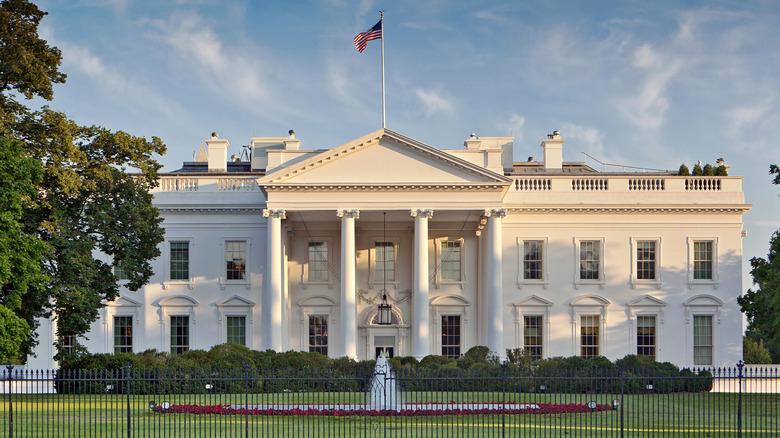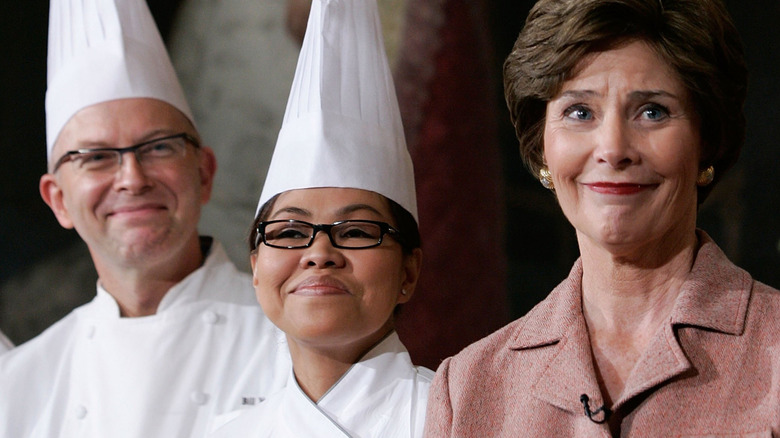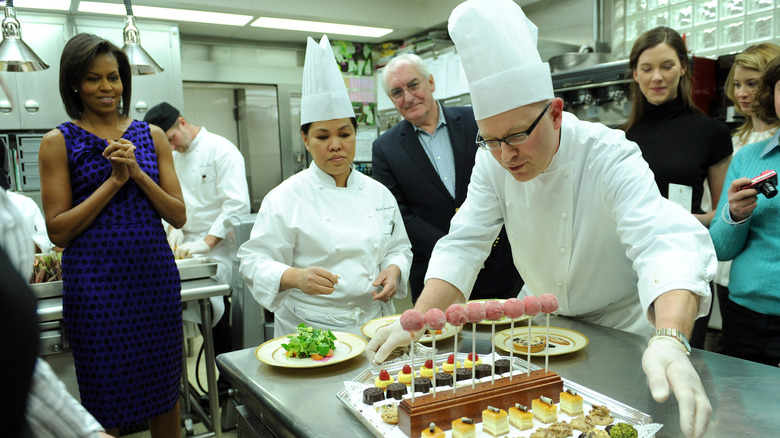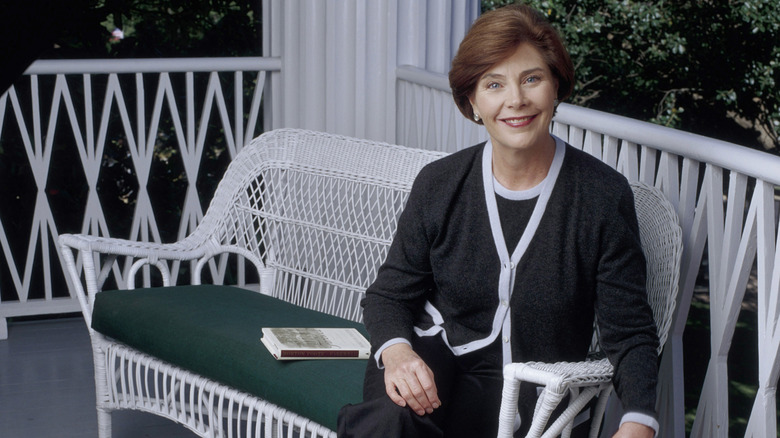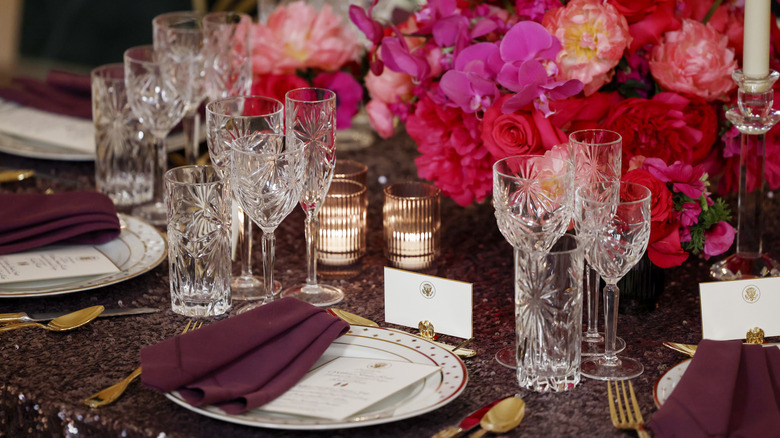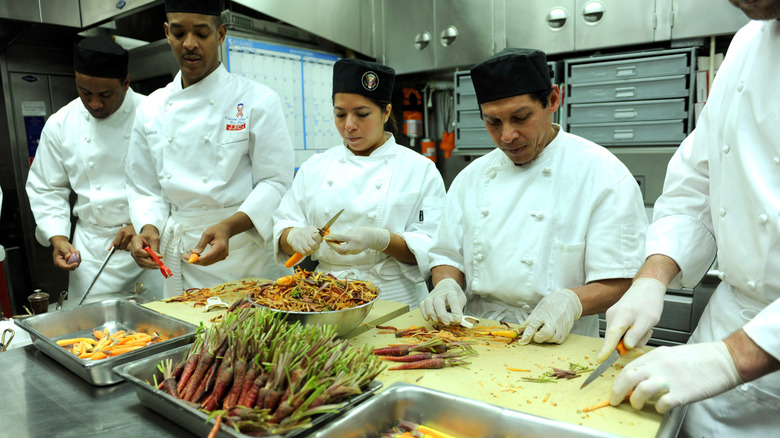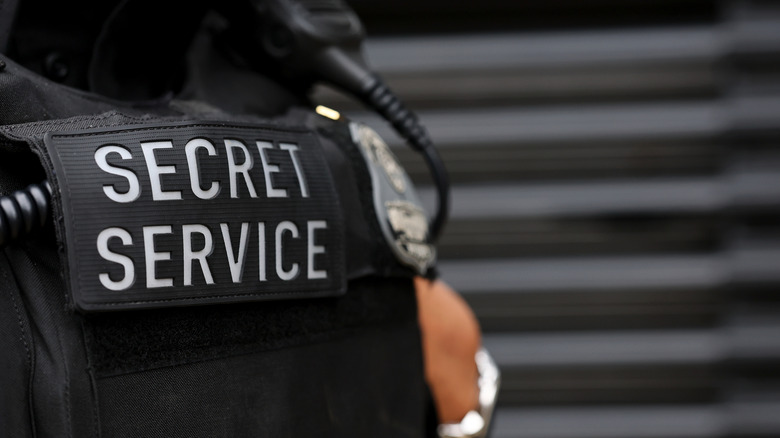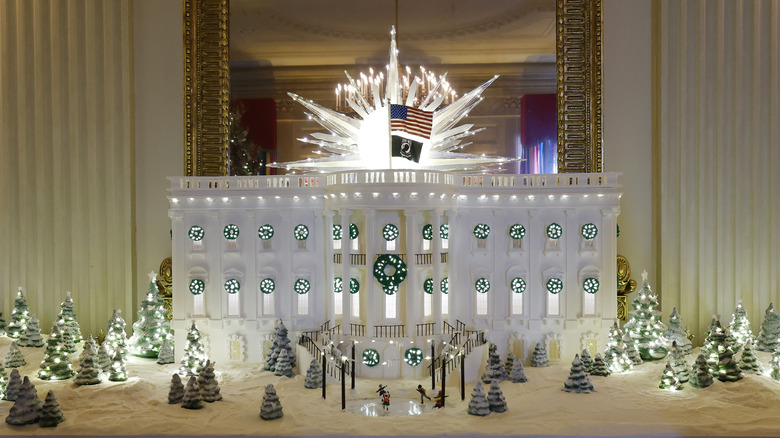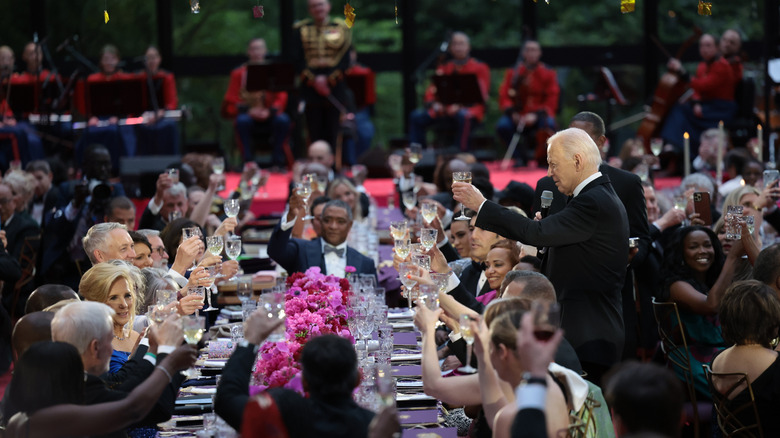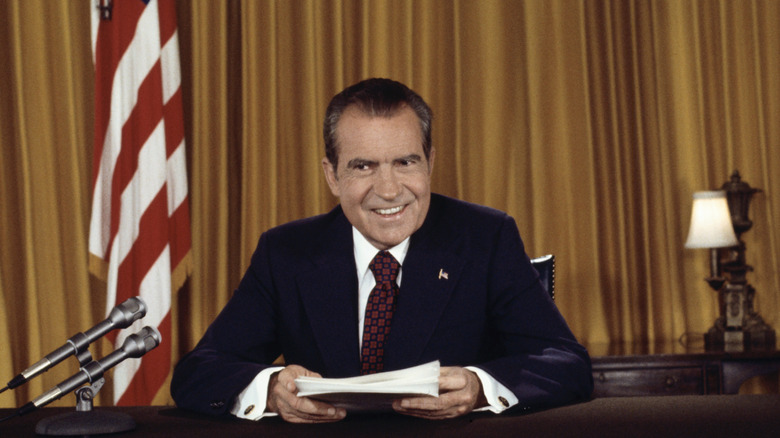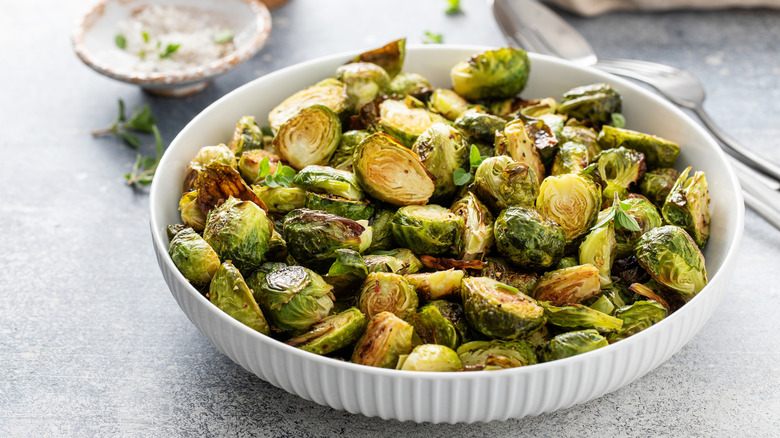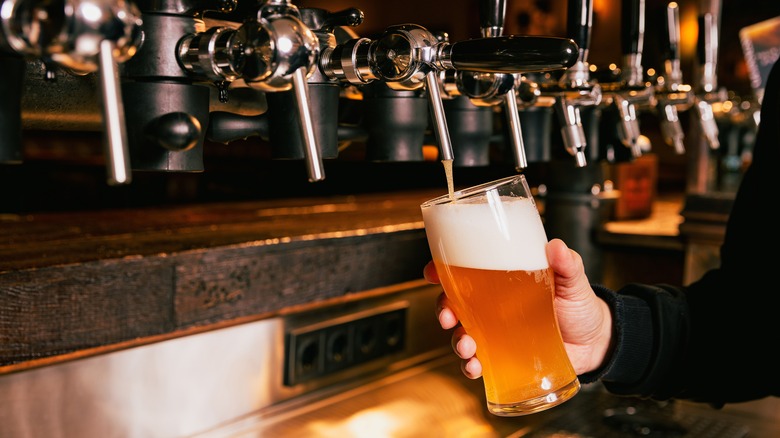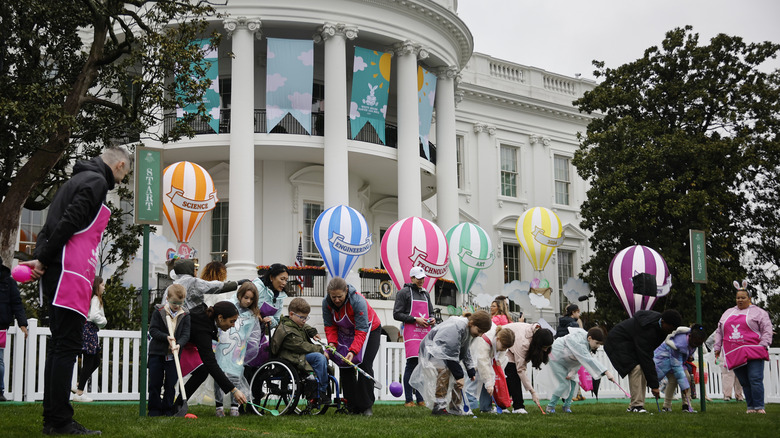White House Chefs Have Some Strict Rules To Follow
Working as a personal chef comes with an enormous amount of pressure. Tailoring your cooking to just one person leaves little room for error. But for this select group of private chefs, a mistake doesn't just mean leaving a sour taste in a client's mouth. It could derail a meal with respected government officials or, even worse, compromise their safety. While most private chefs work for wealthy clients or celebrities, this select team of chefs serve the POTUS.
The White House chef's job description includes more than the usual culinary duties a private chef may be accustomed to. Not only does the team have to make delicious (and beautiful) meals, but they have to navigate working in one of the most secure buildings in the country. Unsurprisingly, cooking in such a high-profile, high-security setting comes with a unique set of strict rules that all staff — including those in the kitchen — must adhere to. Let's dive into some facts about the team of chefs who keep the president and their family fed, along with some key rules they must follow.
The White House kitchen team can consist of more than 20 chefs
The White House chef team consisted of 26 chefs during the Clinton administration, although its size can fluctuate. Not all chefs share the same amount of responsibility though. While some chefs work part-time, others work full-time hours. Likely due to the high demands of the job, the majority of the chef team works part-time. Those in these roles typically act as assistant chefs to full-time kitchen staff.
While the White House chef staff consists of many talented individuals, the team is led by just one: the executive chef. Responsible for feeding the President and their family daily, planning state dinners, and overseeing the rest of the chef team, the executive chef holds perhaps the most important — and most demanding — role of the bunch. The highly coveted position saw a historic change back in 2005 when First Lady Laura Bush appointed Cristeta Comerford to the role of executive chef, making her the first woman to ever hold the position.
The Hiring process is shrouded in secrecy
There is no singular path to the White House kitchen. White House chefs possess a diversity of culinary backgrounds, with some hailing from the restaurant business and others from military kitchens. But earning a spot in the kitchen of the nation's highest office is far from a straightforward application process. There appears to be some sort of selective appointment system to secure a position. Former White House pastry chef Bill Yosses expressed that he had been contacted by the White House after his success working at various high-end restaurants in New York. Although the true hiring process remains unclear, it's safe to say that the White House isn't exactly releasing formal job applications to fill these highly coveted roles.
Perhaps even more of a well-kept secret are the inner workings of the selection process for the White House executive chef. In fact, candidates are prohibited from discussing it with the public. According to the New York Times, doing so can result in candidates' removal from consideration for the position.
The White House executive chef must report to the first spouse
The spouse of the president is responsible for appointing and overseeing the duties of the White House executive chef. Although the first spouse's influence over the White House kitchen has been in place for decades, the title of the executive chef's role has changed over the years. Despite the job description appearing to be similar, the Roosevelt administration did not have an executive chef but a "Head Housekeeper" who worked closely with First Lady Eleanor Roosevelt.
Just like each president has the ability to re-appoint new cabinet members upon the beginning of a new term, the first spouse maintains the ability to fire executive chefs hired by previous administrations. After being hired by Hillary Clinton, who served as the first lady at the time, in 1994, executive chef Walter Scheib was terminated by First Lady Laura Bush when President George W. Bush began his second term in 2005. While the first spouse's ability to quickly let go of an executive chef who isn't performing to their liking points to a potential lack of job security for this demanding role, many other members of the chef team have worked in the White House kitchen for decades.
White House chefs must be on call at all times
If the president is craving a late-night snack once the sun goes down and a long day of work turns into a long night, they're in luck. White House chefs are available 24/7 to cater to the president's culinary needs. While this sounds like quite a heavy commitment, the reality is a bit more nuanced. Around-the-clock service is more of a theoretical part of the job description than a frequent occurrence.
Former White House pastry chef Bill Yosses has expressed in interviews that while chefs are technically always on call to come into work at any given moment, it isn't common to be called in to prepare food for the First Family at unusual hours. This sentiment was echoed by former White House executive chef Walter Scheib who admitted they didn't do much in the way of midnight snacking preparations. Of course, the team makes sure to keep the family's private kitchen full of food options, but otherwise, they are relatively hands off when it comes to late night snacking.
White House chefs do not receive overtime pay
Despite the long hours and the on-call nature of their work, the White House chef team does not receive overtime pay. While it may be unlikely for the president to call them in at 2 a.m. to whip up a late-night meal, it's still a part of the job description and very much an expectation. If such a request were to occur, the chefs wouldn't receive any additional compensation beyond their typical salary of $80,000 to $100,00 for their time, even though they're working in the nation's highest office.
As for the funding of the White House kitchen, all White House staff members, including the chefs, have salaries that are paid for by the government. But not all of the expenses needed to keep the White House kitchen running come from taxpayer dollars. The First Family is still responsible for footing the bill for their groceries and other personal household items and expenses, much like any other American family. This distinction is meant to ensure that only expenses that are specific to the presidential role — such as hosting state dinners and other government events — are covered by the government, rather than the family's daily dinners.
White House chefs must adhere to a variety of security measures
Like any White House employee, chefs must undergo a thorough hiring process, starting with a security screening to ensure they don't pose a safety risk to the president. For that reason, military chefs are often ideal candidates. Former White House chef and army veteran Andre Rush expressed that his "top-secret security clearance" didn't hurt when it came to landing the position.
But the attention to safety doesn't stop at the hiring process. A White House chef's job isn't solely about preparing meals to perfection. They must also watch out for the First Family's well-being. Every food item, whether it's part of a formal meal or a casual snack, is screened to ensure that it hasn't been tampered with and is safe to eat.
While it isn't surprising that the president's food receives the same level of protection as the president themselves, having every piece of food subjected to thorough inspection certainly isn't something many of us can relate to.
Some members of the White House chef team have specialities
The executive chef isn't the only one with a special role in the White House kitchen. The team includes its very own pastry chef, whose primary responsibility is creating pastries and desserts for White House dinners and events.
One of the most notable parts of this chef's role is the annual gingerbread house they are tasked with creating for the holiday season. Far from what you typically buy at the store, the culinary creation must be intricately crafted, ornately decorated, and larger than life. And that's not an exaggeration. In 2015, Susan Morrison, an executive pastry chef under the Obama administration, created a gingerbread house that weighed 475 pounds.
But creating such a grand display takes time. Morrison worked on the iconic house for 11 months, beginning her brainstorm in January and submitting a design proposal in June. So while many of us are soaking up the summer sun, it's safe to say the White House pastry chef is already looking toward snowier days as they plot out a dessert that will be on display for all to see come December.
State dinners have their own set of rules
White House state dinners are typically held to honor foreign heads of government during their visit to the United States. But these affairs are far from your average dinner. In fact, these meals come with a few strict rules of their own that White House chefs must follow to the letter.
Meticulously planned, each state dinner includes a unique menu tailored to the specific guest it is meant to honor. The meal consists of multiple courses — all of which are decided upon by a select group of four to five individuals long before the event takes place. The meal must last exactly 55 minutes, with the timer starting once the first course is set onto the table.
One of the more obscure rules of the event is that second portions of a course are allowed upon request but never offered. While the reasoning behind this is unclear, the precision required for the dinner to run smoothly — within the very specific allotted time frame, nonetheless — may be a reason why White House chefs don't want to risk disrupting the flow of the event.
There appears to be little room for error when it comes to running a state dinner. You might imagine that orchestrating such an event could leave the executive chef with a few more gray hairs by the end of the night.
The president can make even the strangest food requests
White House chefs have been tasked with preparing some rather unusual meals for some former presidents. Considering that all of the food the president and their family eats is both screened and prepared by the White House chef team, the team has bore witness to some pretty odd concoctions. One of the most infamous examples was a request from Richard Nixon for cottage cheese and ketchup for breakfast. After being advised by a doctor to incorporate cottage cheese into his diet, Nixon opted to top the dairy product with ketchup to mask the cheese's natural flavor and make it more tolerable. Whether the chefs found the food combination to be a bit odd or not, they still made sure to serve it to him every morning.
Nixon wasn't the only president with a peculiar breakfast habit. Former Presidents Ulysses S. Grant and Woodrow Wilson had some creative choices as well, with Grant requesting a cup of black coffee and a vinegar-soaked cucumber every morning and Wilson opting for a glass of grape juice mixed with two raw eggs to kickstart his day. Still, no matter how bizarre the request, White House chefs remain ready to tackle the challenge.
Presidential food bans can limit the ingredients White House chefs are allowed to cook with
While presidents have the authority to request specific foods, they can also ban ones they dislike. During his presidency, George H.W. Bush famously banned brussels sprouts from being served in his meals. After former White House executive chef Pierre Chambrin served the vegetable to Bush during dinner one evening, the former president instructed the butler to let Chambrin know to never serve them again. It's safe to say Bush wasn't sending any compliments to the chef that night.
But not all foods receive full bans. President Bush was also said to have disliked broccoli, but since the first lady enjoyed the green veggie, it was still allowed to be used for her meals. While personal food preferences are common and something we all possess, the extent to which a president can "ban" a dish is an ability unique to the nation's highest office.
White House chefs are often met with challenges outside their culinary expertise
Cooking meals isn't the only task a president may assign their chef team. Sometimes chefs are pushed outside of their comfort zone, taking on challenges that may fall beyond their expertise. In 2012, President Obama brought a brewing kit into the White House kitchen and asked his team of chefs to brew beer, marking the first batch of beer ever brewed on the premises.
In a video posted to The Obama White House YouTube Channel, Sam Kass, a White House assistant chef, walks viewers through the brewing process. Since no one on the kitchen staff had prior experience brewing beer, team members turned to other members of the White House staff for guidance. Then beekeeper at the time, Charlie Brandts, proved to be quite helpful as his experience brewing beer in his home equipped him with the ability to offer the team valuable advice. With the White House kitchen having the potential to become a full-blown brewery, it's clear that nothing is out of the realm of possibilities when it comes to working as a White House chef. Clink! Clink!
White House chefs boil and dye countless eggs for Easter
The White House pastry chef isn't the only one tasked with an immense culinary undertaking for celebratory purposes. Every year during Easter, the big rule for the chef team is that they're responsible for preparing tons of eggs for the White House Egg Roll. The event, which dates back to 1878, is a day-long celebration held on Easter Monday where attendees can play games, watch live entertainment, and participate in the annual Egg Roll. This tradition, which originally took place on Capitol Hill, involves kids rolling eggs down the White House's South Lawn.
But, of course, you can't have an Egg Roll without eggs. In previous years, the White House culinary team played an essential role in putting the event together, boiling and dying thousands of eggs for the big day. In 1998, the Los Angeles Times reported that the White House chef staff dyed 7,200 eggs in preparation of the event. While there may not be an official record for "most eggs dyed in a short time frame," this would surely be the front-runner.

